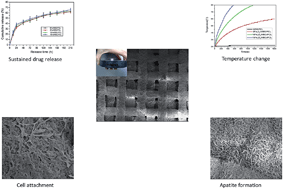3D-printed magnetic Fe3O4/MBG/PCL composite scaffolds with multifunctionality of bone regeneration, local anticancer drug delivery and hyperthermia
Abstract
In this study, three-dimensional (3D) magnetic Fe3O4 nanoparticles containing mesoporous bioactive glass/polycaprolactone (Fe3O4/MBG/PCL) composite scaffolds have been fabricated by the 3D-printing technique. The physiochemical properties, in vitro bioactivity, anticancer drug delivery, mechanical strength, magnetic heating ability and cell response of Fe3O4/MBG/PCL scaffolds were systematically investigated. The results showed that Fe3O4/MBG/PCL scaffolds had uniform macropores of 400 μm, high porosity of 60% and excellent compressive strength of 13–16 MPa. The incorporation of magnetic Fe3O4 nanoparticles into MBG/PCL scaffolds did not influence their apatite mineralization ability but endowed excellent magnetic heating ability and significantly stimulated proliferation, alkaline phosphatase (ALP) activity, osteogenesis-related gene expression (RUNX2, OCN, BSP, BMP-2 and Col-1) and extra-cellular matrix (ECM) mineralization of human bone marrow-derived mesenchymal stem cells (h-BMSCs). Moreover, using doxorubicin (DOX) as a model anticancer drug, Fe3O4/MBG/PCL scaffolds exhibited a sustained drug release for use in local drug delivery therapy. Therefore, the 3D-printed Fe3O4/MBG/PCL scaffolds showed the potential multifunctionality of enhanced osteogenic activity, local anticancer drug delivery and magnetic hyperthermia.


 Please wait while we load your content...
Please wait while we load your content...